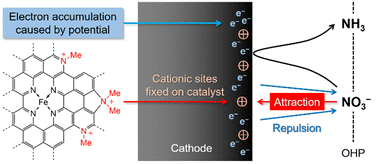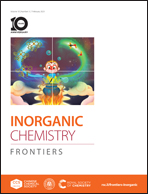Cation modified Fe–N–C catalyst for the electrochemical reduction of nitrate in solutions of low ionic strength†
Abstract
Electrochemical reduction of nitrate (NO3−) driven by intermittent renewable electricity is a promising strategy for water treatment. However, NO3− reduction in solutions of low ionic strength is difficult due to the electrostatic repulsion between negatively charged cathodes and NO3−. Adding a supporting electrolyte is one of the most popular strategies to facilitate NO3− reduction in solutions of low concentration. The improved performance of NO3− reduction is due to the screening of the interfacial electric field by the supporting electrolyte. Another possible strategy is to anchor cationic sites on the catalyst. To demonstrate this strategy, an Fe–N–C catalyst was prepared by the pyrolysis method and cationic sites were introduced by methylation of N atoms uncoordinated with Fe atoms. Methylation of the catalyst resulted in the negative shift of the potential of zero charge and weaker repulsion between the catalyst and NO3−. The electrocatalytic NO3− reduction performances were tested in solutions of low NO3− concentration and the ionic strength of the solution was comparable to that of actual river water. The methylated Fe–N–C catalyst exhibits higher activity towards NO3− reduction, whose partial current density of NH3 is 9.4 times that of the Fe–N–C catalyst. This work demonstrates that decorating catalysts with ionic groups is an efficient way to modulate the electrocatalytic activity in solutions of low ionic strength.

- This article is part of the themed collection: Inorganic Chemistry Frontiers Emerging Investigator Series 2022–2023


 Please wait while we load your content...
Please wait while we load your content...